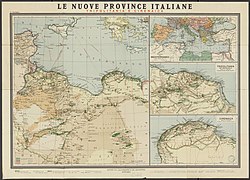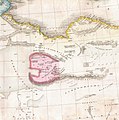Ottoman Tripolitania
| Ottoman Tripolitania ایالت طرابلس غرب (1551–1864) Eyālet-i Trâblus Gârb ولايت طرابلس غرب (1864–1912) Vilâyet-i Trâblus Gârb | |||||||||||||||
|---|---|---|---|---|---|---|---|---|---|---|---|---|---|---|---|
| Eyalet and Vilayet of Ottoman Empire | |||||||||||||||
| 1551–1912 | |||||||||||||||
 The Tripolitania Eyalet in 1795 | |||||||||||||||
| Capital | Tripoli | ||||||||||||||
| History | |||||||||||||||
| 1551 | |||||||||||||||
• Karamanli dynasty rises to power | 1711 | ||||||||||||||
| 1801 | |||||||||||||||
• Ottoman Empire reestablishes direct control | 1835 | ||||||||||||||
| 1912 | |||||||||||||||
| |||||||||||||||
| Today part of | Libya | ||||||||||||||
Ottoman Tripolitania, also known as the Regency of Tripoli, was officially ruled by the
Like the Ottoman regencies in Tunis and Algiers, the Regency of Tripoli was a major base for the privateering activities of the North African corsairs, who also provided revenues for Tripoli.[1][2] A remnant of the centuries of Turkish rule is the presence of a population of Turkish origin, and those of partial Turkish origin, the Kouloughlis.
History
This section needs additional citations for verification. (August 2023) |
| History of Libya | ||||||
|---|---|---|---|---|---|---|
 | ||||||
|
||||||
|
| ||||||

Ottoman conquest
By the beginning of the 16th century the Libyan coast had minimal central authority and its harbours were havens for unchecked bands of pirates. The
Under the Ottomans, the
In 1611, the local chiefs of the area conducted a coup d'état and successfully appointed Suleiman Safar, their own leader, as dey (local chief). As a result, his successors continually held the title and even occasionally identified as pasha.[5]
Karamanli dynasty and the Barbary Wars
During the 18th century, Ottoman power waned in North Africa, with the sultans ending the practice of sending pashas to Tripoli, Algiers and Tunis. The title of pasha began to assume its hereditary status.[6]
In 1711, Ahmed Karamanli, an Ottoman cavalry officer and son of a Turkish officer and Libyan woman, seized power and founded the Karamanli dynasty, which would last 124 years. The 1790–95 Tripolitanian civil war occurred in those years.
In May 1801, Pasha Yusuf Karamanli demanded from the United States an increase in the tribute ($83,000) which it had paid since 1796 for the protection of their commerce and enslavement of crews by barbary pirates when the Treaty of Tripoli was signed. The demand was refused by third American President Thomas Jefferson, an American naval force was sent and blockaded Tripoli, and the desultory First Barbary War dragged on from 1801 until 3 June 1805. The Regency of Tripoli was defeated by the newly revived United States Navy.
The Second Barbary War (1815, also known as the Algerian War) was the second of the two wars fought between the United States and the Ottoman Turks' North African regencies of Algiers, Tripoli, and Tunis, known collectively as the Barbary States.
On 5 September 1817, Yusuf Karamanli invited the leaders of the Libyan tribe of Al-Jawazi to his castle in
Reassertion of Ottoman authority
In 1835 the government of Sultan
It was one of the first Ottoman provinces to be reclassified from an eyalet to a vilayet after an administrative reform in 1865, and by 1867 it had been reformed into the Tripolitania Vilayet.[9]
The Ottoman sultan Abdulhamid II twice sent his aide-de-camp Azmzade Sadik El Mueyyed to meet Sheikh Sanusi to cultivate positive relations and counter the West European scramble for Africa.[10]
The highpoint of the Sanusi influence came in the 1880s under the Grand Senussi's son, Muhammad al-Mahdi al-Sanusi. With 146 lodges spanning the entire Sahara, he moved the Senussi capital to Kufra.[citation needed]
Over a 75‑year period, the Ottoman Turks provided 33 governors[citation needed] and Libya remained part of the empire until Italy invaded for the second time in 1911.
Italo-Turkish War
The
As a result of this conflict, the Ottoman Turks ceded the provinces of Tripolitania, Fezzan, and Cyrenaica to Italy. These provinces together formed what became known as Libya.
Administrative divisions

By the 19th century, the province of Tripoli, known officially as Tarablus al-Gharb ('Tripoli of the West') was organized into five sanjaks (districts):[11]
- Sanjak of Tarablus al-Gharb (Tripoli)
- Sanjak of Khums
- Sanjak of Jabal al-Garb
- Sanjak of Fezzan
- Sanjak of Benghazi (Cyrenaica)
These district names were reported by James Henry Skene in 1851[12] and five districts of the same name existed after the reforms of the 1860s that transformed the province officially into a vilayet (or wilayah in Arabic).[11] Among these, Cyrenaica was made an independent sanjak in 1863 that was directly dependent on Istanbul, then it was assigned to Tripoli's supervision in 1871, and finally it was attached to Istanbul again in 1888.[11][13]
Gallery
-
1667 map
-
The "Kingdom of Tripoli" (Royaume de Tripoly) is shown as including much of modern-day Libya on a map by Guillaume Delisle (1707).
-
1736 map
-
1747 map
-
1771 map
-
Tripolitania in 1818
-
1907 map
See also
- Karamanli dynasty
- Pasha of Tripoli
- Treaty of Tripoli
- Turgut Reis
References
- ^ ISBN 978-1-135-03654-6.
- ^ ISBN 978-0-292-76192-6.
- ISBN 0521337674.
- ISBN 0521337674.
- ^ ISBN 978-1-78607-241-2.
- ISBN 978-0-88029-175-0.
- ^ "Libyan tribe demands to prosecute Turkey for the massacres committed against its people, similar to that of the Armenians". horizonweekly.ca. 5 October 2016.
- ^ مذبحة الجوازي.. دماء 10 آلاف ليبي تطارد إردوغان. 3thmanly.com/ (in Arabic). 18 October 2018.
- ^ Almanach de Gotha: annuaire généalogique, diplomatique et statistique. J. Perthes. 1867. pp. 827–829. Retrieved 2013-06-01.
- ISBN 978-1-7371298-8-2.
- ^ ISSN 0020-7438.
- ^ Skene, James Henry (1851). The Three Eras of Ottoman History, a Political Essay on the Late Reforms of Turkey, Considered Principally as Affecting Her Position in the Event of a War Taking Place. Chapman and Hall. p. 76.
- ISBN 978-1-78076-109-1. Retrieved 2013-05-17.
External links
- Cana, Frank Richardson; Keane, Augustus Henry (1911). . Encyclopædia Britannica. Vol. 27 (11th ed.). pp. 288–292.









